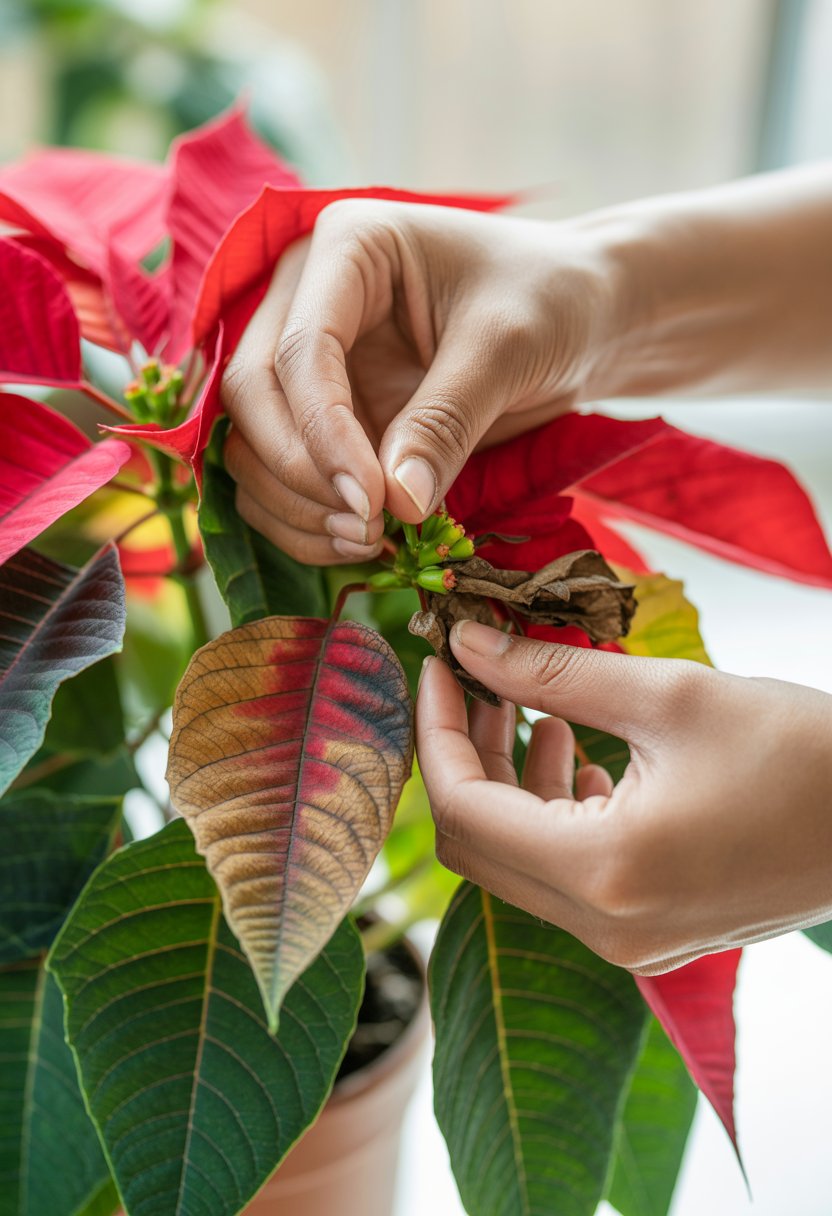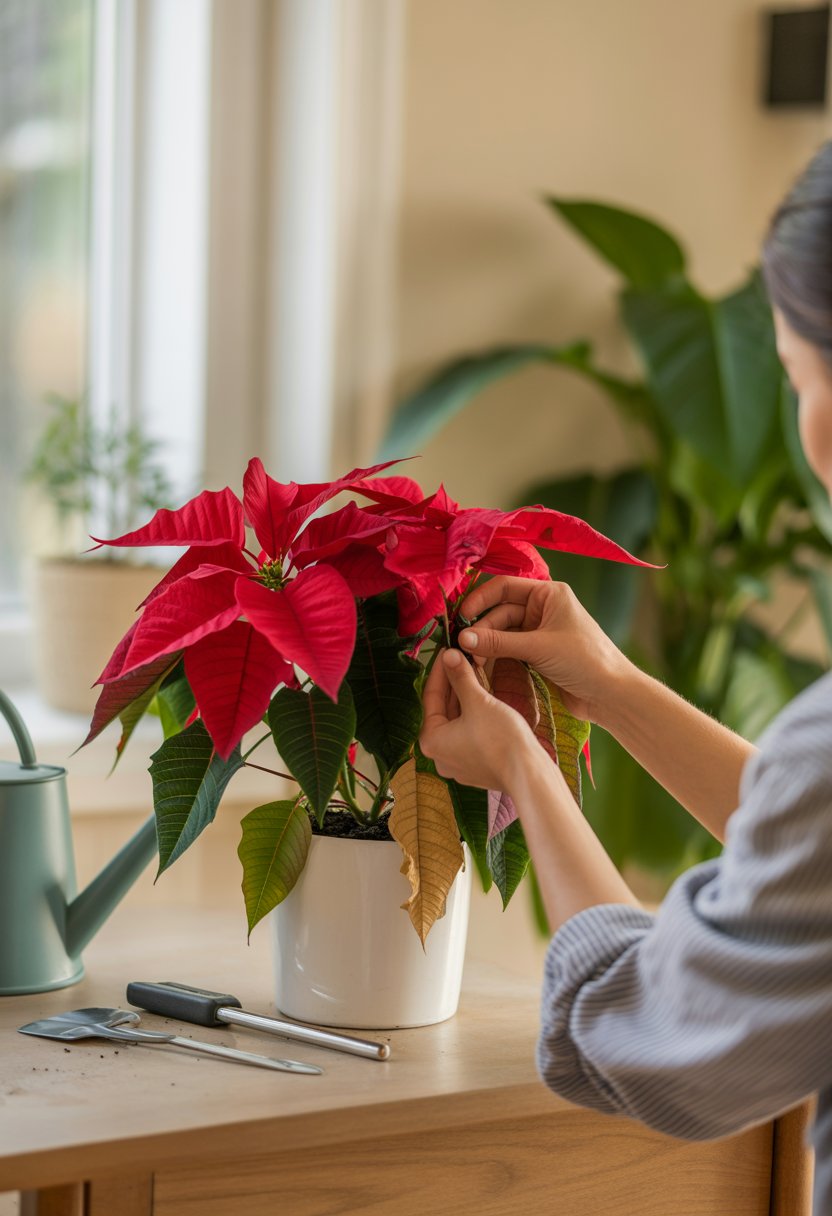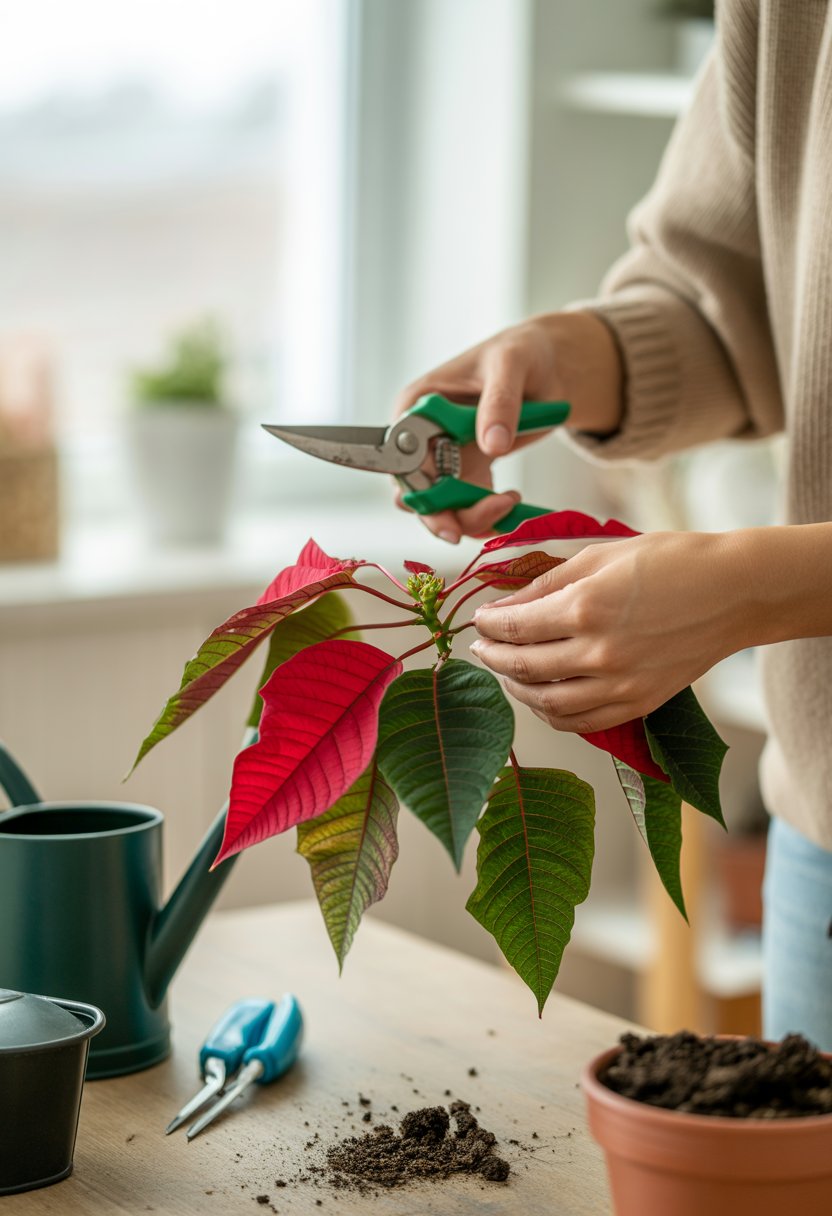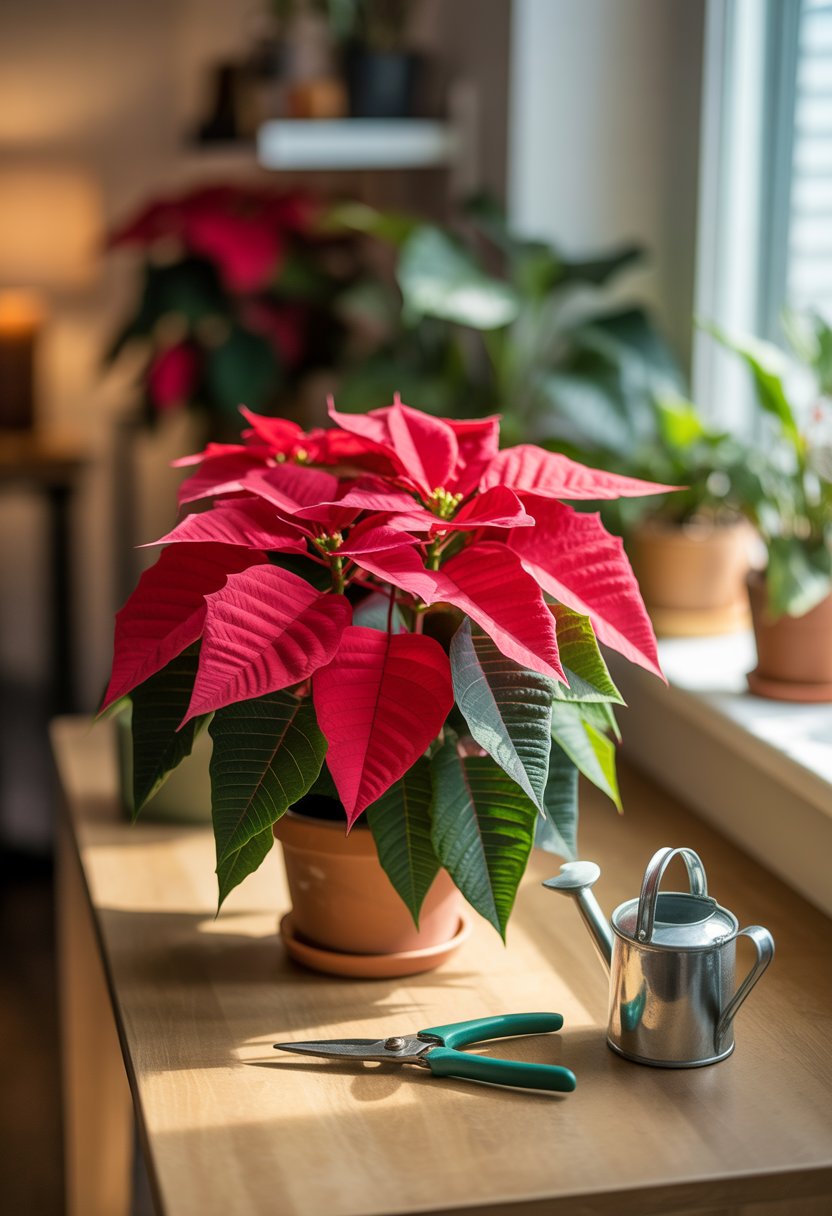Poinsettias, known for their bright colors during the holiday season, are native to Mexico and thrive in tropical regions. Many people enjoy these plants indoors but assume their beauty fades after the holidays, leading them to discard the plant soon after winter. In reality, poinsettias are perennial tropical plants that can continue to grow and flourish as houseplants beyond the holiday months.

With a little attention, poinsettias can maintain healthy green foliage throughout the year and even be placed outside during the warmer seasons. Bringing them back inside before colder weather arrives gives them the chance to produce their colorful display again. By understanding their origins as tropical plants and providing the right care, anyone can enjoy poinsettias in their home year-round.
Reviving Wilting Poinsettias and Promoting Healthy Growth

Poinsettias can start to look unhealthy after the holidays. The bracts, which are colorful leaves and not real flowers, fade away as the plant gets older. When this happens, it’s common for leaves to drop and for stems to look bare or weak. Instead of throwing the plant away, several steps can help restore a poinsettia and keep it healthy for years.
One key step is pruning. Use clean, sharp scissors or pruners to cut back each stem to about three or four inches above the soil. Leave any healthy green leaves below the cut line. After pruning, the poinsettia might look tired, but this is normal. By cutting it back, the plant can regrow stronger and produce new leaves.
How To Save Dying Poinsettia Plants – Keeping Poinsettias Alive After The Holidays!
Proper Light and Placement
Poinsettias need the right amount of sunlight to recover. Place the plant near a window, but not directly in the sun. Bright, indirect sunlight works best. Too much direct light can burn the new leaves, while too little results in weak, leggy growth.
Proper airflow is helpful for regrowth and prevents common problems like mold or fungal infections. Avoid setting poinsettias near air vents, radiators, or heaters, as these can cause low humidity or sudden temperature changes. High humidity encourages healthy growth, while dry air might cause bracts and leaves to dry and drop.
Watering Schedule and Soil Moisture
Consistent, careful watering is important for saving a dying poinsettia. The soil should be kept moist but never soggy. If it dries out more than a couple of inches below the surface, water the plant thoroughly until water drains out the bottom. Empty any water left in the drainage tray to avoid root rot.
On the opposite end, over-watering is a common reason for root rot and wilting. Roots need to breathe, and soggy soil suffocates them. Always use a pot with proper drainage holes. A moisture meter is helpful for monitoring soil dampness.
| Symptom | Likely Cause | Solution |
|---|---|---|
| Yellow leaves | Overwatering/root rot | Let soil dry, check drainage |
| Wilting leaves | Underwatering/cold air | Increase watering, move to warm spot |
| Leaf drop | Cold or drafty area | Move away from windows or doors |
| Bracts fading | Natural cycle/old age | Prune and wait for regrowth |
| Turning black | Frost/cold damage | Avoid temperatures below 50°F |
Preventing Common Poinsettia Problems
- Avoid cold drafts: Poinsettias are sensitive to temperatures under 50°F. Keep them away from doors, leaky windows, or cold porches to prevent leaf drop or blackening of bracts.
- Maintain humidity: Low humidity can cause leaves to curl or drop. Group poinsettias with other plants or use a humidity tray. Misting the plant lightly can also help.
- Repot as needed: If roots are crowded or growing out the drainage holes, re-pot into a slightly larger container with well-draining potting mix.
- Use balanced fertilizer: During spring and summer, feed with a general-purpose houseplant fertilizer after pruning. Stop fertilizing in late summer to encourage bract development in fall.
Spring and Summer Care Tips
When weather warms in the spring, poinsettias can be moved outside. Choose a patio or a place with bright, filtered light and protection from strong winds. Outdoor temperatures should always be above 55°F, especially at night. Poinsettias need plenty of sunlight to build healthy foliage, but too much direct midday sun may scorch the leaves.
During the growing season, it’s helpful to prune back stems to around six inches a couple of times. This keeps plants compact, encourages bushy growth, and prevents them from getting spindly. Prune once in early spring and again in mid to late summer. Every time after cutting, feed with a little all-purpose fertilizer to help the plant store energy.
Remember, poinsettias can be grown outside in flowerbeds or pots. Bring them indoors again before night temperatures drop below 55-60°F, placing them near a sunny window.
Encouraging Bract Color Change
To get poinsettias to form colorful bracts for the holidays, they need long periods of darkness. Starting in the fall, the plant should get 14 hours of darkness every night for about six weeks. To do this, place the plant in a dark closet or cover with a large box every evening, then move it back into bright light each morning.
Starting the darkness routine in early October can lead to bracts changing color by Thanksgiving. For Christmas blooms, begin mid to late October. This process is important to help poinsettias develop red, pink, or white bracts in time for the holiday season.
Repotting for Healthier Roots
As poinsettias grow, their roots may fill up the pot, making it hard for the plant to absorb water and nutrients. If new leaves are small or the plant dries out quickly, it’s time to repot. Transfer the poinsettia to a new container about 25% bigger than the old one, using high-quality, well-draining potting mix. This gives roots more room and helps prevent root rot.
After repotting, continue regular watering and keep the plant in bright, indirect light to support its adjustment to the new pot.
Recognizing and Treating Problems
Some signs of distress are easy to spot. Wilting, yellowing leaves, or drooping bracts can point to overwatering, underwatering, or temperature extremes. If bracts or leaves turn black, this could be from frost damage or cold drafts. Dry leaf tips may point to low humidity.
To fix these problems:
- Water only when the soil feels dry a couple inches down.
- Keep the plant away from drafts and cold spots.
- Raise humidity levels by grouping plants or misting.
- Prune back damaged or dead leaves with clean scissors.
Summary Table: Poinsettia Care at a Glance
| Care Area | What to Do | What to Avoid |
|---|---|---|
| Light | Provide bright indirect sunlight | Avoid direct hot sun |
| Temperature | Keep 65-75°F (18-24°C) | Never below 50°F |
| Water | Keep soil lightly moist | Don’t let soil stay soggy |
| Humidity | Maintain moderate humidity | Avoid dry air |
| Fertilizing | Use balanced fertilizer in growing months | Don’t fertilize in fall |
| Pruning | Trim after bracts fade; in spring and summer | Don’t skip pruning |
| Repotting | Repot if roots fill the pot | Avoid dense, non-draining soil |
Preventing Disease and Pests
Poinsettias sometimes suffer from fungal diseases like root rot, often caused by too much water and poor drainage. Well-draining pots and soil, plus letting the top inch or two of soil dry between watering, greatly reduce this risk. Occasionally, pests like whiteflies may appear. These can be washed off or treated with gentle bug soap.
Extra Tips for Healthy Poinsettias
- Use a well-draining pot with several drainage holes. This helps prevent standing water at the bottom, which leads to root rot.
- Check for moisture with a moisture meter or finger. Water only when the soil feels just a bit dry.
- Avoid sudden temperature changes. Poinsettias do not like cold blasts or hot air from vents.
- If possible, use rainwater or distilled water. Tap water with chemicals or salts can cause leaf tips to turn brown.
For further details on proper humidity, avoiding root rot, and how to treat wilting or yellowing, see university extension guides and tips for keeping poinsettias alive well past the holidays. If your poinsettia is suffering from dropping leaves, yellow patches, or limp stems, you may find additional helpful advice on reviving a dying poinsettia, including how to enhance airflow and use a balanced fertilizer.
A poinsettia can thrive with attentive care, proper watering, and protection from harsh conditions year-round. With regular attention, pruning, and the right environment, these plants will reward owners with colorful displays during the holiday season and beyond.
Tips for Reviving and Caring for Struggling Poinsettia Plants

Poinsettias often suffer from problems caused by overwatering, underwatering, or not getting enough sunlight. To help a poinsettia recover, it is important to follow some simple care steps.
Proper Watering
- Water only when the top inch of soil feels dry.
- Avoid letting the plant sit in standing water; empty any extra water from the saucer.
- Too much or too little water can lead to wilting and root problems (more here).
Right Light
- Place the plant where it receives about six hours of bright, indirect sunlight each day.
- A spot near a window that faces south, east, or west is ideal (read more).
Temperature and Humidity
- Keep the poinsettia away from cold drafts, heating vents, and sudden temperature changes.
- Increase humidity by misting the plant or placing a tray of water nearby (learn how).
Quick Reference Table
| Care Tip | What To Do |
|---|---|
| Watering | Check soil and water when dry |
| Sunlight | Give at least six hours of indirect light daily |
| Temperature | Avoid drafts and extreme heat or cold |
| Humidity | Mist leaves or use a pebble tray |
By following these steps, many poinsettias can recover and continue growing. Always check the roots for signs of rot if the plant was overwatered, and remove any dead or damaged leaves.
Frequently Asked Questions

How do you help a drooping poinsettia recover?
A poinsettia that looks limp or wilted often needs water, but not too much. The soil should be damp but not soggy. Place the plant in bright, indirect light and keep it away from cold drafts or direct heat. Sometimes trimming off any dead or yellowing leaves can also help the plant focus its energy on new growth. For more guidance, visit this step-by-step guide to reviving a wilting poinsettia.
What actions should be taken if all the leaves have fallen off a poinsettia?
If a poinsettia has lost all its leaves, check if the stems are still firm and green. Cut back any dry or dead stems. Move the plant to a spot with filtered light and water only when the soil is almost dry. With patience and regular care, new leaves might grow back.
How do you know if a poinsettia has been given too much water and how can it be fixed?
Signs of an overwatered poinsettia include yellowing leaves, a musty smell, or black, soft roots. To help the plant recover, remove it from its pot and check the roots. Cut away any mushy or black roots, then replant in fresh, well-draining soil. Adjust the watering schedule so the soil dries out a bit between waterings. For more tips, see these steps for saving an overwatered poinsettia.
What are the steps to restore a poinsettia’s bright color?
To encourage a poinsettia to color up again, make sure it gets plenty of bright, indirect sunlight during the day. Starting in early fall, give it about 14 hours of darkness each night for at least two months. Maintain a steady room temperature and avoid sudden shifts in light. Only feed with fertilizer during active growth and reduce feeding as it prepares to bloom.
Can a poinsettia that seems lifeless be brought back?
Even if a poinsettia looks dead, it may not be gone. Check if any stems are still pliable and green inside; if so, there’s a chance for recovery. Remove all dried or dead parts, water lightly, and provide gentle light. It may take a few weeks, but as long as the roots and some stems are alive, the plant could recover. Find more on how to try saving a poinsettia that seems beyond help.
What precautions help stop wilting when moving a poinsettia to a new pot?
When repotting, use fresh, well-draining soil and a pot with drainage holes. Water right after repotting, but do not let the roots sit in extra water. Handle the roots carefully to avoid injury. Repotting should be done when the soil is slightly moist, not dry or soaked, to lower the risk of shock. Use clean tools to prevent spreading diseases.

